Chocolate semifreddo + Carmela Soprano's delicious bribe
Guittard chocolate giveaway + favorite books on chocolate + Carmela's rigot pie + live Q&A on Monday, 6pm PST for all subscribers
Welcome to chocolate week! Here’s the tl;dr:
Guittard Chocolate giveaway for anyone who signs up for paid
I was fired from a job for a chocolate-related disaster
Some favorite books on chocolate, all include gluten-free recipes
Carmela Soprano’s Ricotta-PIneapple pie recipe—fast, easy, really delicious
Chocolate Semifreddo with Dark Chocolate Cake recipe
Monday: join me live at 6pm PST where I’ll be on Substack chat answering your questions about baking with chocolate - open to all subscribers
THE GIVEAWAY: My favorite chocolate for baking and snacking, Guittard Chocolate is giving away three branded tote bags of chocolate and cocoa to three lucky Have Your Cake paid subscribers! Upgrade by May 17th for a chance to win.
Each tote contains NINE full-size items: two 12 ounce bags of organic Baking Wafers—Milk Chocolate, and Semisweet Chocolate; two containers of different types of Cocoa; Unsweetened Baking Bars; Semisweet Baking Bars; and three bags of chips: Butterscotch, Santé (sweetened with coconut sugar), and Semisweet chips. Retail value is $84.
In case anyone wants to upgrade from free to paid, I’ll hold the drawing on May 17th and subscribers will be notified via Substack dm to provide full name and shipping address. Items can be shipped anywhere in the United States or Canada. If there is no response after 5 days, alternate winners will be randomly chosen.
I’ve been looking forward to creating this Chocolate Semifreddo recipe since coming up with the idea of this newsletter. I love chocolate—eating it, baking with it, and I’d bathe in it if I could—and I really love Guittard chocolate, a small, innovative, family company that started 150 years ago during the California Gold Rush, and is still run today by the Guittard family.
Semifreddo, if you haven’t made one, is simply eggs whipped with sugar, folded into melted chocolate, and then folded with whipped cream and frozen. No ice cream maker required, minimal ingredients, and the recipe creates an airy, soft frozen dessert—a texture like a light, frozen mousse. An added benefit of semifreddo: because it’s stabilized with eggs like a mousse, it won’t melt into a puddle when serving to a crowd (it just stays mousse-y).
I created the dark chocolate cake component just for this semifreddo, and it has two main differences that give it the qualities I was looking for: it has a little more sugar than I would normally use because food tastes less sweet when frozen—it’s one of the reasons ice cream tastes so sweet when melted, but just right when cold—and the combination of almonds and starch and extra sugar give the cake a beautiful, semi-soft texture even from the freezer (some cakes turn rock-hard when frozen). It would also be a great layer to use if you’re into making ice cream cakes.
Also, I like the symmetry of this recipe: Guittard cocoa is used in the cake, and their semisweet chocolate is used in the semifreddo, giving lots of chocolate dimension to the dessert.
The photos don’t do this dessert justice—I was reminded of this time in my twenties when I was asked by a caterer to take photos for their brochure of a five-gallon bowl of chocolate mousse at an outdoor buffet in bright noon sun, and I only had minutes to get a shot before the party descended. I was fired when they saw the contact sheets of my attempts to make the giant bowl look appetizing–not my best work. Chocolate cake has no bad angles; stirring a bowl of melted chocolate, chocolate eclairs, even a bar of chocolate—all gorgeous and easy to photograph. Amazing how we can hearken back to the sting of life’s failures after 30 years like it was just yesterday, despite having successes—and fortunately my job now is creating beautiful and delicious food!
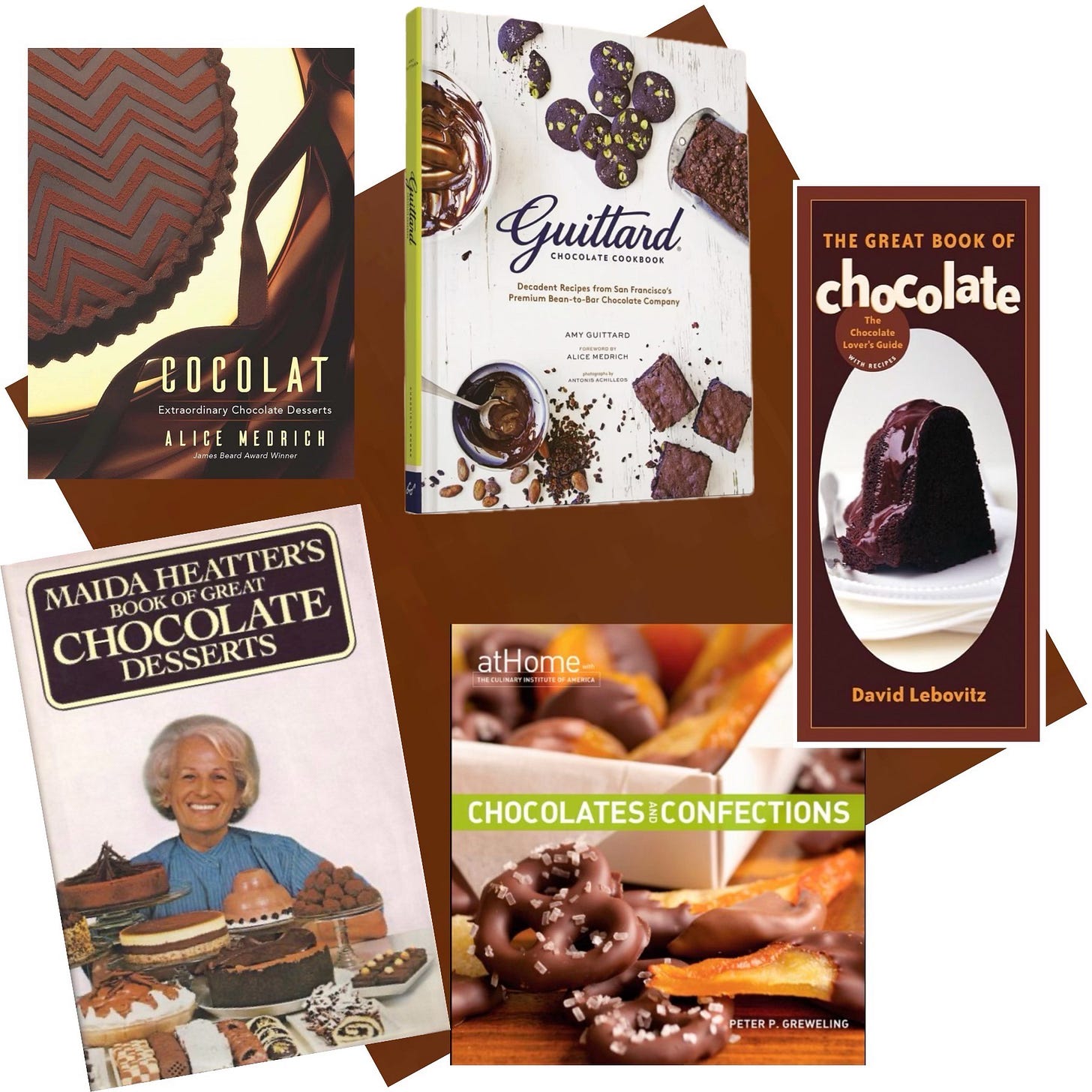
There are too many to fully list, but here’s a few of my favorite books on the subject:
Cocolat by Alice Medrich was the 1991 James Beard cookbook of the year, and it’s obvious why: Medrich was founder of the beautiful Cocolat shops and the book includes all of her recipes that made the shops famous.
Guittard Chocolate Cookbook, Decadent Recipes from San Francisco’s Premium Beat-to-Bar Chocolate Company by Amy Guittard. The title really says it all: 60 wide-ranging recipes interspersed with family and chocolate company history, with beautiful photography.
The Great Book of Chocolate by David Lebovitz. Besides being written by one of the best pastry chefs anywhere (check out his Substack), David covers how chocolate is grown, the process of making, and profiles some of the world’s top chocolatiers. And so many great recipes.
Chocolates and Confections written by Peter Greweling for the Culinary Institute of America, Greweling was my chef-instructor when I attended CIA in 1990, and his recipes are perfect and meticulous and you’ll learn so much about how to work with chocolate from this book—I still do!
Maida Heatter’s Book of Great Chocolate Desserts If you don’t already own it, this book is a treasure trove of all kinds of desserts, and contains a lot of gluten-free options. One of my favorites, hands down. I’ve given away so many of these, and keep picking them up at used book stores.
ON TO THE RECIPES!
Rigot pie: I love a good show to binge almost as much as I love cooking and baking, and once I saw Carmela’s rigot pie during my current Soprano’s binge, I knew I had to make it—it shows up several times, most famously as a bribe to get Carmela’s daughter into Georgetown.
There’s two Sopranos cookbooks, and both have surprisingly great ratings on Amazon, as well as shockingly high sales rankings for what would normally be a one-off vanity project. As with the show, they hired the best—Michele Scicolone—a renown and highly regarded Italian cookbook author, to develop the recipes. I wrote to Michele because I was dying to know more about the cheesecake and developing recipes for the books in general, but haven’t heard back yet.
I used fresh pineapple instead of canned, and made some other adaptations; even though you end up cooking your fresh pineapple, fresh-cooked has a much better flavor, if you have some. If you want to refer the original recipe, I’ve included a screenshot from the book. It’s a low pie with a plain, lightly sweetened ricotta filling that gets topped after baking with pineapple thickened with a little starch and chilled. The “crust” is simply made by buttering the pie plate and coating with crushed, gluten-free grahams. It sounds a bit odd in theory, but it works, and creates a faint bottom layer (although the recipe won’t suffer if you skip that step). It’s so good. Really really.
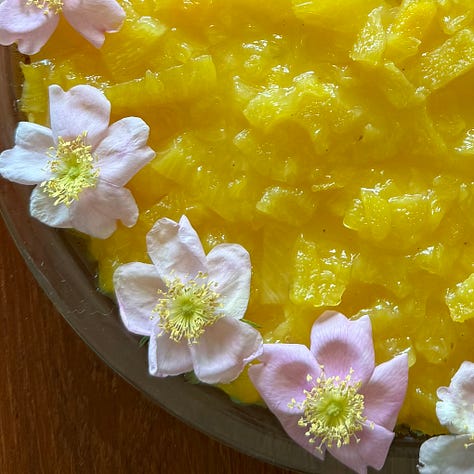
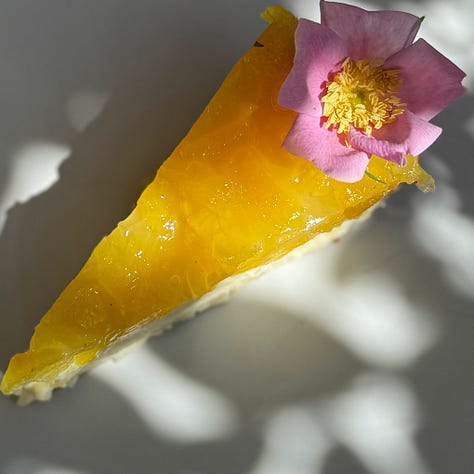
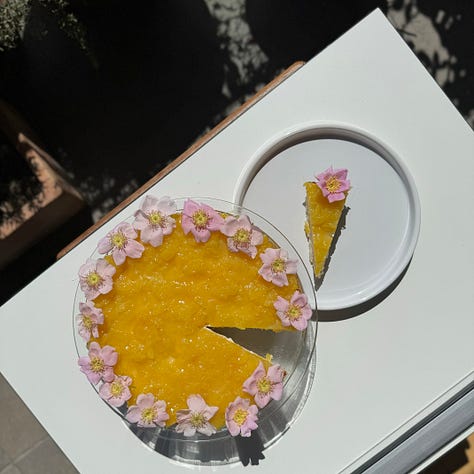
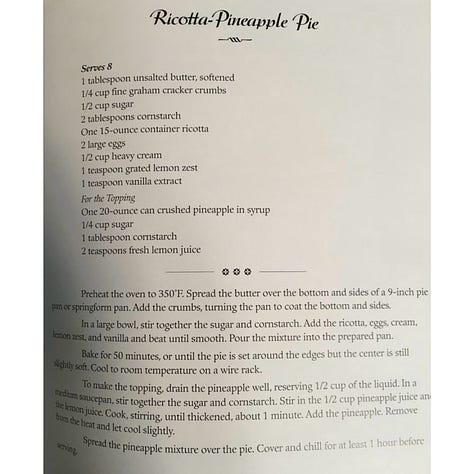
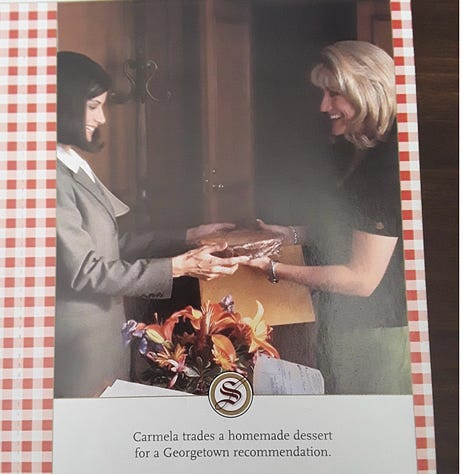
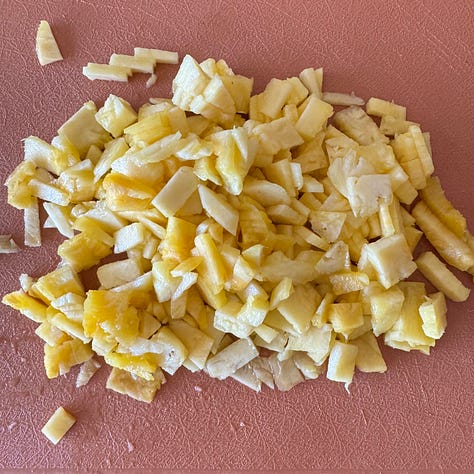
RECIPE
Carmela’s Ricotta-Pineapple cheesecake (adapted)
There’s a screenshot of the original version of the recipe, but I made a few changes; I lowered the baking temperature a bit, as 350ºf can make the mixture soufflé. At 325ºf the cake will have a creamier texture. I also made a few other little tweaks, like adding a little salt, and increasing the lemon juice and zest a little.
Yields one 9-inch pie (double quantity of cake for deep dish and use same amount of topping)
Cake
• 60ml / 1/4 C graham cracker crumbs (or any similar cookie)
• 1 Tbs butter, soft
• 100g / 1/2 C sugar
• 2 Tbs cornstarch
• 425g / 15 oz ricotta, whole milk
• 2 eggs, large
• 120ml / 1/2 C heavy cream
• zest from 1 lemon
• 1 Tbs lemon juice
• 1 tsp vanilla
• 1/2 tsp kosher salt
Preheat oven to 325ºf. Butter pie plate and coat with graham crumbs (or your favorite cookie crumbs), tilting dish around to get it evenly distributed. Gently tap out excess. Set aside. You could skip this step and simply butter the pie plate and omit the crumbs.
Mix sugar and cornstarch together. Add ricotta and mix to combine. Add eggs one at a time, whisking to combine. Add the rest of the ingredients and whisk til smooth.
Transfer to prepared pie dish and bake for 35 minutes (bake time is highly dependent on type of pie plate used). Center should still be just a touch wobbly. Bake another five minutes if necessary. Cool on rack.
Pineapple topping
• 500g / 17.5 oz fresh pineapple (or see screenshot above for canned fruit version)
• 60ml / 1/4 C sugar
• 1 Tbs lemon juice
• pinch salt
• 1 Tbs cornstarch
• 2 Tbs pineapple liquid set aside (if you don’t have any, use water)
Cut pineapple in 1/8-inch by 1/4- to 1/2-inch pieces (as shown in photo), or in the dimensions you prefer. Combine with sugar, lemon juice, and salt in a pot, bring to a boil, lower heat, and cook with lid on for 5 minutes; the juices will start to exude from the fruit after a few minutes. Check, mash the pineapple with the back of a wooden spoon against the side of the pot to break up some of the pieces. Cook another few minutes.
Combine the cornstarch with the reserved pineapple juice (or water) to make a slurry. Pour into the pot with the pineapple and bring back to the boil. Boil for one minute and take off the heat. Cool for a few minutes, and transfer to the top of the cheesecake, spreading the topping to the edges of the cake.
Cool to room temperature and chill until ready to serve. Pie will keep in the refrigerator, covered, for five days.
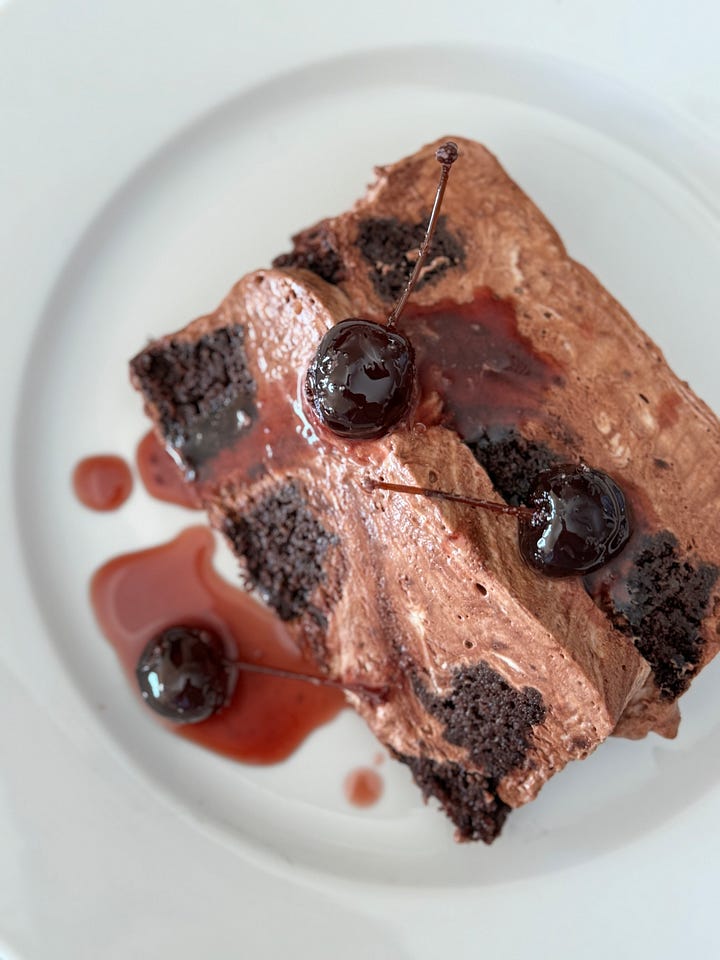
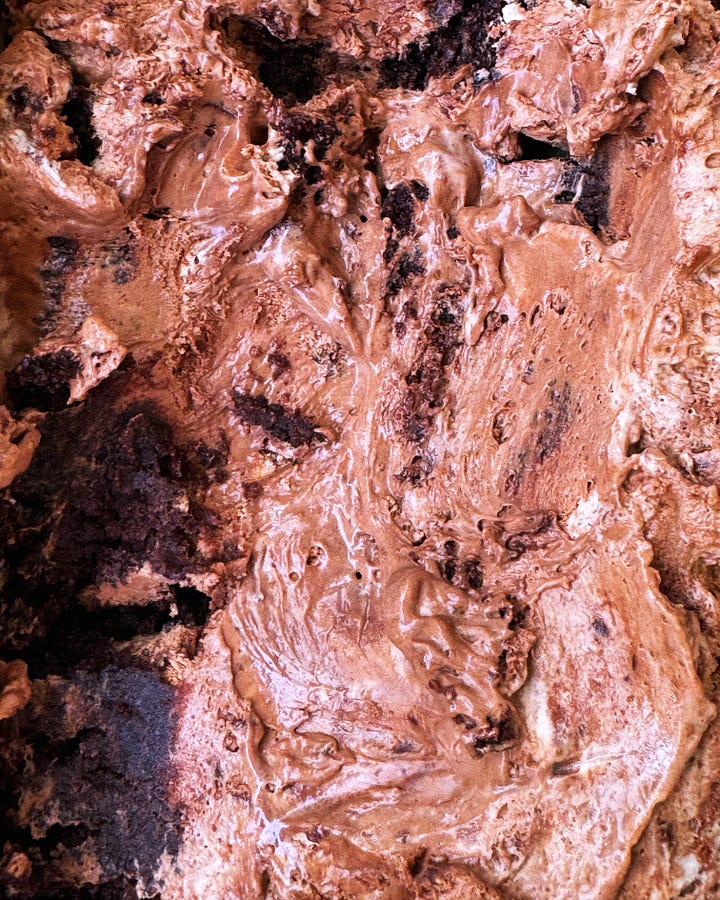
Chocolate Semifreddo with Dark Chocolate Cake
Keep reading with a 7-day free trial
Subscribe to Have Your Cake to keep reading this post and get 7 days of free access to the full post archives.



